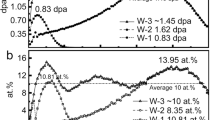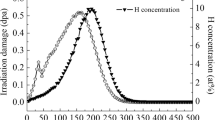Abstract
The effect of isochronal annealing on vacancy-type defects in quenched FeCrNi alloys and SUS316 was investigated via positron annihilation technique. Vacancy-type defects clustered and grew with increasing annealing temperatures of up to 523 K and, in FeCrNi alloys, were gradually annihilated with increasing temperature. The annihilation temperature was relatively insensitive to the addition of Mo and nonmetal elements, and after annealing at 673 K, the vacancy-type defects were annihilated and dislocation-type defects were formed in all of the alloys. In addition, due to the formation of Mo-vacancy complexes, the density of defects in the Mo-diluted FeCrNi model alloy was lower than that in the FeCrNi model alloy. The long lifetime of vacancy-type defects in commercial stainless steel SUS316 was smaller than that in the FeCrNi model alloys due to the nonmetal-element-induced change in mobility of the defects. Moreover, the vacancy-type and dislocation-type defects contributed to the S and W parameters of positron annihilation during the entire annealing treatment.



Similar content being viewed by others
References
C. Sun, Y. Yang, Y. Liu, K.T. Hartwig, H. Wang, S.A. Maloy, T.R. Allen, X. Zhang, Thermal stability of ultrafine grained Fe–Cr–Ni alloy. Mater. Sci. Eng., A 542, 64–70 (2012)
E. Kuramoto, T. Tsutsumi, K. Ueno, M. Ohmura, Y. Kamimura, Positron lifetime calculations on vacancy clusters and dislocations in Ni and Fe. Comput. Mater. Sci. 14, 28–35 (1999)
C. Sun, K.Y. Yu, J.H. Lee, Y. Liu, H. Wang, L. Shao, S.A. Maloy, K.T. Hartwig, X. Zhang, Enhanced radiation tolerance of ultrafine grained Fe–Cr–Ni alloy. J. Nucl. Mater. 420, 235–240 (2012)
T. Yoshiie, K. Sato, X. Cao, Q. Xu, M. Horiki, T.D. Troev, Defect structures before steady-state void growth in austenitic stainless steels. J. Nucl. Mater. 429, 185–189 (2012)
M. Horiki, T. Yoshiie, K. Sato, Q. Xu, Point defect processes in neutron irradiated Ni, Fe–15Cr–16Ni and Ti-added modified SUS316SS. Philos. Mag. 93, 1701–1714 (2013)
S. Zhu, Y. Zheng, D. Yuan, Y. Zuo, P. Fan, D. Zhou, Q. Zhang, X. Ma, B. Cui, L. Chen, W. Jiang, Y. Wu, Q. Wang, L. Peng, X. Cao, B. Wang, L. Wei, Effect of triple ion beams on radiation damage in CLAM steel. AIP Conf. Proc. 1533, 179–183 (2013)
K.L. Wong, H.-J. Lee, J.-H. Shim, B. Sadigh, B.D. Wirth, Multiscale modeling of point defect interactions in Fe–Cr alloys. J. Nucl. Mater. 386–388, 227–230 (2009)
M. Lambrecht, A. Almazouzi, Positron annihilation in neutron irradiated iron-based materials. J. Phys. Conf. Ser. 265, 012009 (2011)
R. Wang, X. Liu, A. Ren, J. Jiang, C. Xu, P. Huang, Y. Wu, C. Zhang, X. Wang, Proton-irradiation-induced damage in Fe–0.3 wt% Cu alloys characterized by positron annihilation and nanoindentation. Nucl. Instrum. Methods Phys. Res. Sect. B 307, 545–551 (2013)
M. Horiki, T. Yoshiie, S.S. Huang, K. Sato, X.Z. Cao, Q. Xu, T.D. Troev, Effects of alloying elements on defect structures in the incubation period for void swelling in austenitic stainless steels. J. Nucl. Mater. 442, S813–S816 (2013)
S.M. He, N.H. van Dijk, H. Schut, E.R. Peekstok, S. van der Zwaag, Thermally activated precipitation at deformation-induced defects in Fe–Cu and Fe–Cu–B–N alloys studied by positron annihilation spectroscopy. Phys. Rev. B 81, 094103-1–094103-10 (2010)
S. Novy, P. Pareige, C. Pareige, Atomic scale analysis and phase separation understanding in a thermally aged Fe–20 at.% Cr alloy. J. Nucl. Mater. 384, 96–102 (2009)
T. Ishizaki, Q. Xu, T. Yoshiie, S. Nagata, The recovery of gas-vacancy-complexes in Fe irradiated with high energy H or He ions. Mater. Trans. 45, 9–12 (2004)
Y. Nagai, K. Takadate, Z. Tang, H. Ohkubo, H. Sunaga, H. Takizawa, M. Hasegawa, Positron annihilation study of vacancy-solute complex evolution in Fe-based alloys. Phys. Rev. B 67, 224202-1–224202-6 (2003)
H. Wu, X. Cao, G. Cheng, J. Wu, J. Yang, P. Zhang, Z. Li, A.Z.M.S. Rahman, R. Yu, B. Wang, Effects of copper precipitates on micro defects in deformed Fe-1.5 wt% Cu alloy. Phys. Status Solidi A 210, 1758–1761 (2013)
B.Y. Wang, S.H. Zhang, T.M. Wang, Recovery behaviour of quenched-in defects in Fe–Cr–Ni alloy by positron annihilation. Acta Metall. Sin. 33, 271–276 (1997)
J. Qiu, Y. Xin, X. Ju, L.P. Guo, B.Y. Wang, Y.R. Zhong, Q.Y. Huang, Y.C. Wu, Investigation by slow positron beam of defects in CLAM steel induced by helium and hydrogen implantation. Nucl. Instrum. Methods Phys. Res. Sect. B 267, 3162–3165 (2009)
S.I. Porollo, S.V. Shulepin, Y.V. Konobeev, F.A. Garner, Influence of silicon on swelling and microstructure in Russian austenitic stainless steel EI-847 irradiated to high neutron doses. J. Nucl. Mater. 378, 17–24 (2008)
M. Lambrecht, L. Malerba, Positron annihilation spectroscopy on binary Fe–Cr alloys and ferritic/martensitic steels after neutron irradiation. Acta Mater. 59, 6547–6555 (2011)
M.J. Puska, R.M. Nieminen, Defect spectroscopy with positrons: a general calculational method. J. Phys. F Met. Phys. 13, 333–346 (1983)
H. Ohkubo, Z. Tang, Y. Nagai, M. Hasegawa, T. Tawara, M. Kiritani, Positron annihilation study of vacancy-type defects in high-speed deformed Ni, Cu and Fe. Mater. Sci. Eng. A 350, 95–101 (2003)
T. Yoshiie, X. Cao, Q. Xu, K. Sato, T.D. Troev, Damage structures in austenitic stainless steels during incubation period of void swelling. Phys. Status Solidi A 6, 2333–2335 (2009)
Acknowledgments
This work was supported by the National Natural Science Foundation of China, under Grant Nos. 91226103 and 91026006.
Author information
Authors and Affiliations
Corresponding author
Rights and permissions
About this article
Cite this article
Zhang, C.X., Cao, X.Z., Li, Y.H. et al. Thermal evolution of vacancy-type defects in quenched FeCrNi alloys. Appl. Phys. A 119, 1431–1435 (2015). https://doi.org/10.1007/s00339-015-9116-1
Received:
Accepted:
Published:
Issue Date:
DOI: https://doi.org/10.1007/s00339-015-9116-1




